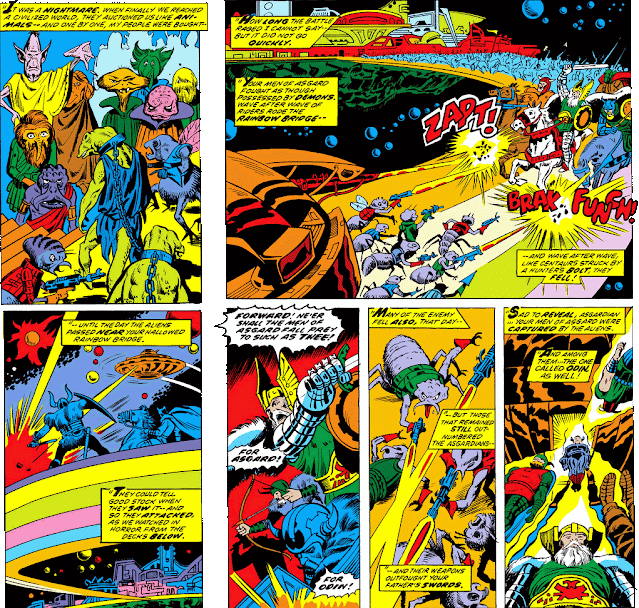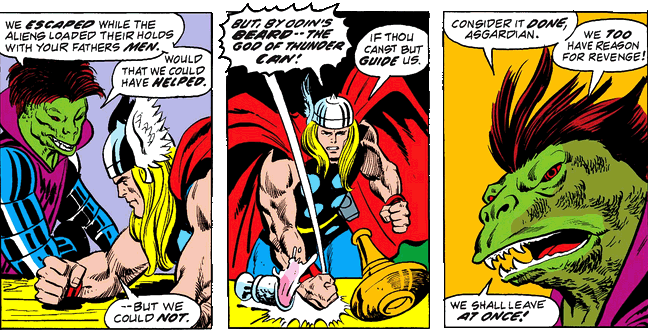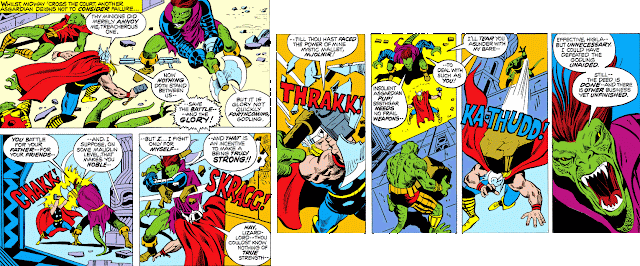OR: "Our Next God Up For Bid..."
In mid-1973, we found the Mighty Thor comic about to wrap up an eight-month stretch of issues that saw the Thunder God and his fellow Asgardians--the Warriors Three, the lady Sif, Hildegarde, and Balder the Brave--exiled on Earth by Odin, and joined by Tana Nile and Silas Grant, two individuals from their conflict with Ego-Prime and now marooned on Earth. To complicate matters for the Earth-bound Asgardians, Sif, in exchange for saving Thor's life in a battle against Loki, would be compelled to serve Karnilla, the Norn Queen, in her quest to locate the now-missing Balder*; and as for Balder himself, he later turns up in a shocking state, apparently having been to Asgard despite Odin's edict and returned with his mind shattered by whatever he endured there.
*Presumably Sif was conscripted by Karnilla because of her power to travel by bypassing space and time--otherwise, Sif's ability to locate missing persons would be on par with any other Asgardian's, and certainly wouldn't begin to approach Karnilla's own mystic resources.
And so we've come to where writer Gerry Conway would pivot sharply to a new and wholly different story arc, beginning a nine-issue series of Asgardian adventures in outer space that kicks off with all of Asgard's warriors being captured by aliens and sold on the auction block!
With Odin being the assumed culprit for Balder's state, Thor gathers his group (with the exception of Volstagg, who stays with the disabled Balder) and transports them all to Asgard, primed for a confrontation--but the mystery deepens from the moment they materialize on Bifrost, and thereafter proceed to investigate a city that appears all but empty.
Asgard's new "residents" turn out to be a race of lizard-beings led by Sssthgar, enduring their own exile following an invasion of the realm by the Vrellnexians--beings who raided other civilizations for those they could later sell for slave labor. And in an encounter between gods and armed, aggressive aliens, it appears that even Asgardians, bred for conflict and war, have a thing or two to learn about winning battles.
And so the Asgardians, along with Sssthgar and his legion, depart for the planet named Golden Star, where their comrades and others who have been plundered from their worlds have been taken. Yet along the way, Conway has chosen to ignore other elements that have contributed to making this story possible. For instance, whatever vague perception we might have had concerning the location of Asgard, whether somewhere in our physical universe or a separate dimensional plane, the fact that the Vrellnexians come across the realm on their way through space is a rather jarring reality check on years of stories which deftly avoided taking a definitive stance on the subject. In addition, there's the matter of Balder, an immortal warrior well versed in dealing with trolls, storm giants, dragons, Mangog, Surtur, and other horrors, yet apparently being driven mad by either the sight of the Vrellnexians or Sssthgar's forces in Asgard and fleeing back to Earth. It wouldn't be until Thor's return to Asgard that Conway touches base with Balder again, instantly reinstated in his usual role and character after having served his purpose, while inexplicably "insane no longer."
There's also the not-so-small situation with Asgard itself, where we're left to assume that the Vrellnexians only absconded with the realm's warriors and left behind their families, to say nothing of the many, many people who lived in other provinces outside the city (including those storm giants et al.). Of course, to put the matter to rest, we could take into account the possibility that the Vrellnexians intended to return, obviously with more ships that could carry an entire kingdom's worth of "stock."
The sight which greets Thor and the others at Golden Star, however, doesn't leave any room for conjecture--evoking only a response of sheer rage on the part of those who won't abide that sight a moment longer. What the Asgardians don't yet realize, however, is that there are details to this situation which Sssthgar has avoided sharing with them.
Yet even with their sights solely on their goal of freeing their liege, Thor and the others begin to notice how strangely reticent and withdrawn Odin seems to be--except to make an effort to urge them all to stand down and flee for their lives, which no doubt elicits a reaction of confusion and no small amount of shock from these warriors who struggle to reach him. And it's when that moment comes that Sssthgar's moment arrives, as well--the time being ripe to take advantage of the way that has been paved for he and his legion to surround their pawns and demand their surrender.
In this struggle, Conway also manages to sidestep another plot convenience--namely, how the Vrellnexians this time were sent packing by Thor and his team, putting aside the fact that their weaponry and tenacity previously allowed them to conquer all of Asgard, Odin included. Clearly, Thor and the others aren't quite ready to throw in the towel in the face of Sssthgar's betrayal; but in a striking contrast, it seems that Sssthgar's forces are even more effective than their former partners at waging war against the Asgardians, as, one by one, Thor's allies fall to these lizard-men, leaving Thor alone to face their leader.
Given the ease at which Sssthgar's men have overwhelmed their foes, we're obliged to keep in mind that, according to Sssthgar, his forces outnumbered the Asgardians 100 to 1--an astonishing ratio, considering that it necessitates the Asgardian sailing vessel which brought them to Golden Star is therefore able to transport over six-hundred people. For the sake of the story, we'll have to assume that the vessel's hold exists on the same principle as a Tardis in terms of its interior size--which reads as ridiculously as it sounds when said out loud, I'm sure.
As for Thor being felled by a mere if sizable chunk of concrete, consider a scene from just two issues prior, when the rock troll Ulik was slamming his opponent through--and with--a few tons of concrete, with the Thunder God rising after each assault. You and artist John Buscema have fleeting memories indeed, Mr. Conway.
When Thor recovers**, he finds himself in the squalor of a dank dungeon along with other prisoners, which include a few of his comrades as well as Lord Odin--all of whom seem to be resigned to their fate. It becomes apparent that Thor is not--and a clue is offered as to why.
**Somehow finding his hammer at his side, as well--because in Conway-land, captors naturally consign their prisoners to a dungeon along with their weapons. How fortunate that one of the aliens was able to lift the hammer from where it fell and tuck it into Thor's belt.
Since we're left to assume that the other Asgardians present would have felt likewise about having to consume such a meal, and thus were likely force-fed, the timing of Thor's meal would indicate it's a stroke of luck that he awoke just before that step could be taken.
And so we now have Thor, Hildegarde, and Tana Nile at large, making plans to best their enemies and recover all of the Asgardian prisoners and depart this world. And we know that the hordes of Asgardian warriors here will all fit comfortably on their sailing ship, so that's one less worry. Granted, events of this story suggest that a complement of only three Asgardians will be as easily captured as the group that earlier numbered twice that size; but Conway also provides an interesting development which may help in that regard, in the form of an underground resistance band made up of refugees from Golden Star's subjugation, who have a sad and tragic story to tell and who now turn to a god for help.
And so with renewed spirit and purpose, Thor and his friends, along with a task force made up of several of the resistance, are off to their assigned missions. Yet, despite having three pages in which to play out, and even with both groups prevailing against Sssthgar, the reader may come away feeling that this story's conclusion falls short.
Again, it appears corners have been cut for the sake of expediency, with only Gregor's group having accomplished something of substance here--though perhaps a short-lived victory, when all is said and done. Sssthgar's forces are still intact, after all, with Thor and Hildegarde having dealt with only a handful of soldiers at most; doing the math, that leaves roughly 580 or so armed lizard-men, and Sssthgar himself, to bring everyone back into line. Once the Asgardians depart, there's nothing really stopping Sssthgar (or the Vrellnexians, for that matter, should they decide to return) from taking steps once more to subdue their victims, and thereafter rebuild the drug facility. In the long run, what has changed?
From here, Thor's search for the missing Sif begins as he and the other Asgardians journey to the Dark Nebula, where they confront the god-jewel known as Xorr, as well as "the fourth-dimensional man" known as Mercurio. Of course, however, the more immediate concern for Thor is: Is his vessel stocked with enough food and ale for Asgard's entire army of ravenous warriors? ;)




























I've slipped in a snarling growl about this story a few times on your inestimable blog, CF, so maybe I shouldn't take up space again.
ReplyDeleteSorry, can't resist.
At this point in my comic collecting career, I had been a fan of The Mighty Thor for about 30 issues. In that span, I had seen Odin shake the universe, re-shape the Earth (after the damage of Infinity), and kill Death. Ignoring that, I'd seen the armies of Asgard employ science-fantasy weapons like the "thunder cannon" against Mangog. BUT, in this story they charge a bunch of bug invaders like medieval cos-players.
And, as you point out, establishing that Asgard just hangs in normal space like a pretty moon was a cretinous concept.
I pretty much rank this as the worst comic book story arc that ever stole a kid's precious allowance. My first traumatic lesson of how comic book publishers will push any schlock to make a buck. Comic book retailers and their stern "This ain't a library kid!" think those kids are reading to avoid paying. I think many kids are taking a sniff to see if they're being offered filet mignon or raw roadkill before spending his cash.
So many questions, so many answers I really don't care about.....did the Vrellnexians somehow feed this gruel drug to the Asgardians before conquering them? A pretty bad story, made even worse by the horrid inking by Don Perlin (!) and Vince Colletta..in the first panel, Balder is totally unrecognizable.
ReplyDeleteA frank assessment as always, Murray! Actually, I wonder if the Vrellnexians landing on Bifrost instead of descending on the city itself had something to do with the Asgardians' decision to make a charge their main offensive; unfortunately, as a result, there was then no room to deploy any "artillery" that might have offset the aliens' weaponry. As for the Vrellnexians' decision to land on the bridge and make their advance from there, I'm guessing they considered it a strategic advantage to restrict any resistance to the confines of the bridge, thus giving the Asgardians no cover and allowing the Vrellnexians to lay down a barrage of weapons fire that cut into their numbers. That doesn't explain Odin refraining from wiping the invaders from existence, but what can I tell you.
ReplyDeleteAnon, I suppose we could justify Balder's appearance more simply as that of a raving man who had become mentally unbalanced, as opposed to any lapse in the work of Buscema/Perlin or Colletta, though to each his own. Frankly, I was so surprised at seeing Balder go without his helmet for once that I'm sure even Karnilla would have done a double-take. :)
Any Thor comic with Tana Nile in it can't be all bad.
ReplyDelete-M.P., Currant Acting Vice-President and Outreach Coordinator, Tana Nile Appreciation Society